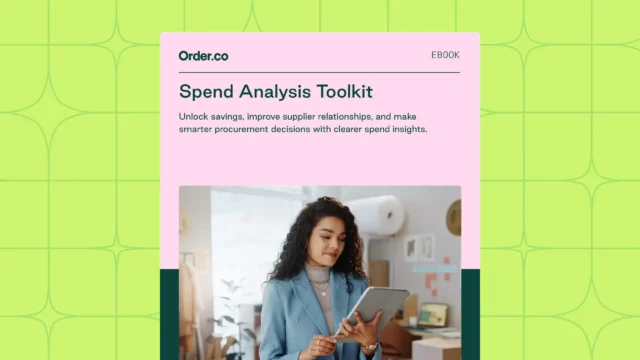What Is Procurement? Types, Processes and Tech

What Is Procurement? Types, Processes and Tech
Every organization engages in some level of procurement strategy, whether using an ad hoc system or administering a comprehensive and well-documented procurement practice. While the specifics of managing and tracking procurement spending may vary, how the process is defined shouldn’t.
But how do organizations define procurement? And is the definition important to company success?
To answer these questions, we’ll help you gain a clear understanding of procurement, including:
- What it is, its importance to your business, and the steps necessary for building a successful procurement strategy
- How using procurement technology can significantly reduce the time and expense of procurement management
- How to improve the procurement cycle in your organization
- Real-world examples of how Order.co helps fast-growing companies achieve streamlined and automated invoice and procurement management
Download the free guide: Spend Analysis Toolkit
What is procurement?
Procurement is the process of sourcing, acquiring, and paying for goods and services. While many organizations use terms like ‘procurement,’ ‘purchasing,’ and ‘sourcing’ interchangeably, these are different components of the total procurement function.
How does procurement differ from purchasing?
While procurement focuses on the end-to-end sourcing and acquisition of supplies, purchasing focuses on ordering and delivery. Procurement management includes all activities that support supply management and acquisition, including:
- Strategic sourcing
- Negotiation and contracts management
- Order approval and fulfillment
- Invoice processing and settlement
- Analysis of procurement data
- Spend management and budgeting
Why is procurement important in business?
Every business requires goods and services to achieve its desired outcomes. Whether software for communication, raw materials for making products, or services to maintain facilities, selecting supplies to keep an organization running is an expensive and time-consuming task.
The primary mission of a procurement department is to acquire necessary goods at the best prices and terms. Procurement professionals also specialize in building supplier relationships, negotiating advantageous contracts, and streamlining procurement workflows.
An effective procurement process helps organizations increase cost savings, eliminate wasteful spending, and optimize budget allocation. Automation further enhances savings, and it can help businesses cut processing costs by $13 or more per invoice. These types of efficiencies drive business growth and help insulate organizations against economic downturns.
Types of procurement
Companies must engage in different types of procurement to meet business needs and immediate goals. These include direct procurement, indirect procurement, goods procurement, and services procurement.
Services procurement: Non-tangible purchases, such as consulting services or facilities repair, fall under services procurement. This category also includes software, with software as a service (SaaS) increasingly becoming one of an organization's most significant service-based expenditures.
Direct procurement: This is the acquisition of goods and services directly related to production. Examples include the raw materials, software, or services that directly support the making of your company's products.
Indirect procurement: indirect procurement is not directly related to producing goods. It includes office supplies, internal communications software, and facilities services not connected to a specific product offering.
Goods procurement: Goods procurement refers to any tangible object purchased, whether finished or unfinished. Raw materials, office supplies, desks, and other physical products are considered goods procurement.
How procurement works
Procurement often accounts for one of the largest portions of revenue spending, so it’s essential to monitor its expenditures carefully. Strong procurement management is one of the most critical components of an organization’s financial health.
The procurement team is responsible for continuously administering and improving the procurement process. Optimizing the procurement lifecycle typically requires cross-departmental efforts with oversight from finance, legal, IT, and supply chain management stakeholders.
While there are many stages of the procurement process, most procurement and purchasing activities fall into one of a few general categories.
Planning: The planning phase includes establishing budgets for departments or teams. The forecasting process happens in cooperation with the finance team and departmental stakeholders.
Sourcing: Sourcing encompasses competitive analysis of current and potential strategic sourcing partnerships to identify the best suppliers for company needs. This evaluation process is conducted in conjunction with department heads and purchasing approvers.
Acquisition/payment: This stage includes ordering, reconciling, and paying for goods and services that meet organizational needs while maintaining spending control. Close attention to prices and terms ensures the best quality products at competitive rates and under favorable conditions.
Evaluation: Evaluation means using past performance and current data to strengthen supplier relationships, prepare for future spending, and uncover further cost savings to improve the bottom line.
Sustainability in procurement
Sustainable procurement has gained significant traction as organizations recognize the strategic and social importance of minimizing their environmental impact. This trend reflects a broader shift toward sustainability in global business practices, where companies evaluate suppliers not only on price and quality but also on environmental and ethical standards.
Sustainable procurement integrates green practices and environmental, social, and governance (ESG) criteria into purchasing decisions to minimize harmful impacts on the planet and society. By adopting sustainable procurement activities regarding more efficient resource use and waste reduction, businesses can realize long-term cost savings, enhance their brand reputation, foster innovation, and contribute to global sustainability goals.
- Fuel optimization: Optimizing shipping routes and using green fuels helps reduce climate impacts.
- Energy efficiency: Evaluating the energy consumption and efficiency of products and services helps reduce carbon footprints.
- Waste management: Assessing suppliers' waste reduction, recycling, and disposal practices minimizes environmental impact.
- Sustainable materials: Giving preference to renewable, recyclable materials lowers environmental impact over a product's lifecycle.
- Ethical labor practices: Ensuring suppliers uphold fair labor practices, including worker rights, leads to safer working conditions.
- Carbon footprint: Considering the total greenhouse gas emissions caused directly or indirectly by an organization or product improves its overall impact profile.
- Water conservation: Assessing water usage and conservation efforts in production processes reduces water waste and environmental impact.
How procurement is tapping AI
The power of automation makes many aspects of work faster and easier, and procurement is no exception. Procurement professionals are now using AI to automate routine tasks, enable data-driven decision-making, and enhance supplier management. The speed and accuracy of AI-powered workflows significantly streamline procurement operations and increase overall efficiency.
Cost comparison: AI can quickly compare the price and total cost of products to ensure you get the best per-item cost on commonly used items.
Stockout replacement sourcing: AI makes it easier to locate exact or similar items in cases of stockouts or insufficient quantities. It also makes it easier to see the total cost of these replacements, including shipping and fees.
Supplier performance management: An AI tool can centralize and simplify the supplier lifecycle, optimizing partnerships and ensuring efficiency using real-time data and predictive analytics.
Invoice processing and payment: AI transforms invoice reconciliation and processing by automating invoicing tasks, reducing errors, speeding up transactions, and automating vendor payments.
Spend analytics and budgeting: Spend analytics platforms incorporate AI into the analysis process, providing insights into expenditure patterns, savings opportunities, and budgeting accuracy.
Steps in the procurement process
Procurement practices are most effective when they follow a repeatable, optimized process. While every procurement team establishes a unique system for sourcing, acquiring, and paying for goods and services, you can use the following general steps to create an effective procurement cycle:
- Identify a need: A stakeholder identifies the need for a product, materials, software, or service to create products or carry out daily business, detailing this need in an intake or requisition form.
- Submit a purchase requisition: The stakeholder submits a purchase request with all necessary details for approval and processing. The request may also include recommended solutions or service providers.
- Evaluate potential suppliers: Procurement evaluates possible options and selects the best vendor. Sometimes, this occurs using a competitive bidding process, such as a request for proposal (RFP), request for quote (RFQ), or a “three bids and a buy” process.
- Negotiate terms and conditions: After selecting the best supplier, the procurement team negotiates pricing and terms. Negotiations should only wrap up once all departmental requirements are met.
- Create a PO: Procurement creates a purchase order to acquire goods or services from the supplier. The PO usually requires approval to ensure it meets expectations before it's sent to the supplier.
- Receive and review goods: The supplier fulfills the order as requested. Once delivered, the procurement team inspects the goods or services for quality and accuracy. If the order falls short, the receiver may request adjustments or return the shipment.
- Reconcile and match: The receiving, accounting, or procurement team performs a three-way match to ensure the shipment, invoice, and PO align.
- Approve and pay the invoice: Once the three-way matching is complete, the supplier invoice is submitted for processing. The invoice is batched, coded, and scheduled for payment.
- Complete post-close activities: The procurement team now completes post-close operations and purchasing analysis, which may include recordkeeping, reporting, spend analysis, supplier evaluation, contract management, and supplier offboarding (in cases where contracts are completed or terminated).
Case study: How Order.co helped WeWork automate procurement
Many companies' procurement processes start out as simple and manageable manual systems. While some accounts payable (AP) teams get by with these processes for a time, manual workflows may not be able to keep up with the increase in orders and invoices that come with company growth.
This was the case for WeWork, a coworking company that had a meteoric rise that led to the addition of over 800 global locations in a few short years. With their growth came a huge increase in invoices—over a million per year and rising. The scale of operations left too much space for out-of-policy spending and surprise invoices that caused confusion and cost money. The company needed a way to streamline and automate processes for more than 2,400 orders per month across 100+ vendors.
WeWork turned to Order.co in 2017 to eliminate its manual processes and automate its procure-to-pay process. With expert help, the company created a fully functional, automated system integrated with Workday to get spending and processing under control. The changes created detailed spend visibility across every location and category, greatly reduced WeWork’s cost per invoice, and resulted in a simple, dynamic process that controlled budgets while allowing stakeholders to get needed supplies.
To learn more about how WeWork used Order.co to revolutionize its procurement process, read the complete WeWork case study.
How Order.co can help manage procurement
Maintaining a streamlined procurement process and analyzing data is no small feat. Even in new and growing companies, procurement may deal with dozens of vendors and thousands of invoices. This generates an excess of data that can only be fully utilized with the help of technology.
Using procurement management software to automate processes and centralize data reduces the strain of manual procurement and allows teams to understand how the organization spends money. When you define procurement processes and empower your organization with the benefits of a robust procurement platform, the savings and productivity quickly add up.
Order.co can help improve the purchase-to-pay process by:
- Allowing businesses to analyze and contextualize purchasing data to set more accurate budgets and plan capacity effectively
- Simplifying the vendor selection process and empowering buyers to use strategic sourcing partners when acquiring goods and services
- Centralizing contract, benchmarking, and supplier data to create better leverage in negotiations
- Automating three-way matching and reconciliation to reduce accounting effort and time
- Streamlining invoicing and vendor payment processes to reduce manual data entry, eliminate invoice exceptions, and integrate and consolidate vendor payments
To better understand how Order.co can help your organization, schedule a demo to see the platform in action.
Get started
Schedule a demo to see how Order.co can simplify buying for your business.
"*" indicates required fields


![7 Benefits to Building a Solid Procurement Strategy & How To Do It [2023]](https://www.order.co/wp-content/uploads/2023/04/iStock-1188425195-640x360.webp)
